Door Karen Holt
I entered my conveyance in Winchester in the happiest of spirits, rejoicing in the safe arrival of Eleanor Rose, and admiring the rapid dispatch with which the lady had managed the business; though, I daresay, my gratitude for the latter could hardly equal her own. The temper of the day was just as fine; growing happily sunny through the morning mist which, I trusted, would disappear completely, or return to plague my excursion, as it saw fit.
Though the journey was but an hour, I was somewhat anxious, being unfamiliar with the country and the post at which I must alight. However the coachman gave polite assurance that he would look sharp, and that I should not travel farther than I intended. My mind relieved on this most material point, I settled back and pulled out my favourite narration of the life of she for whom this pilgrimage was being made. Most meticulously, most excellently researched and written, Miss Clair Tomalin’s account is the one I would recommend above all others to those interested in the life of the delightful creature who, I confess, I take the liberty of calling in my private thoughts, ‘Jane’. Though there were very particular friends I would have delighted in having with me at that moment (most of them reading these lines!), my book was more than companionship enough as we progressed towards Chawton, and the details relayed within gave even more interest to the countryside I saw as I passed.
Remarkable, is it not, how an hour can stretch or shrink? With the headache or dull company, sixty minutes can seem for ever! But when occupied with books, people or meditations you enjoy, the minutes pass as nothing. I can give no other cause for my utter insensibility, my complete astonishment, when the coachman called – seemingly for the second time –”Jane AU-sten!!” I leapt up in confusion, suddenly aware our vehicle must have been at a standstill for some moments, rather disconcerted by the amused glances from fellow passengers – but did not blush. I never blush. Simply gathered my things with great rapidity and departed, with solicitous direction from the coachman as to how to best continue my journey on foot. Of the kind intention of his advice I had no doubt. Of its intelligence, I was pleased to see plain proof not 50 yards hence.
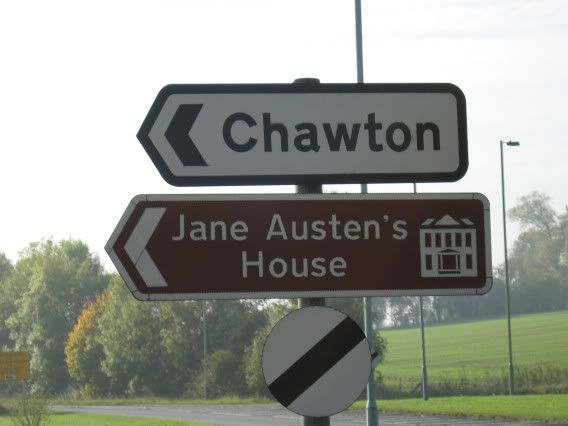
On I walked into the Chawton. Past snug homesteads and hedgerows, small gardens and orchards – I even saw a rabbit dash across a field! Time has laid its hand very gently on the place – it remains a a quiet, idyllic countryside village. The path before me curved along a low red-brick wall lined with high trees on the left. These suddenly disappeared to make way for an expanse of grass – and there it was! Oh, there could be no mistake! The road I walked was one of three that joined and split right in front of me, and there…
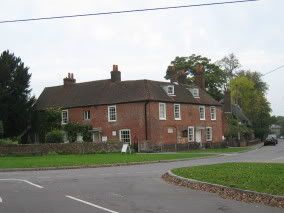
“Chawton village, a dozy place that was startled into attention several times a day by the clatter of rapid coach traffic through its centre, stood where three roads met: to the north, Alton and London; to the south, Winchester if you followed one fork, Gosport along the other. The Austens’ cottage was on the corner of the divide, so close to the road that the beds in the front rooms upstairs were sometimes shaken by the six-horse coaches that thundered past. Slower carriages allowed curious passengers to see into the rooms. “I heard of the Chawton Party looking very comfortable at Breakfast, from a gentleman who was travelling by their door in a Post-chaise,” Mrs Knight (Jane’s sister-in-law) wrote to Fanny (her daughter, and Jane’s niece). Jane liked to look out at the village street, and often looked out the sunny dining-room window where she wrote to enjoy whatever it offered by way of entertainment. She amused herself with the passing traffic: at the start of the Winchester term she observed ‘a countless number of Postchaises full of Boys pass yesterday morning – full of future Heroes, Legislators, Fools and Villains’.”
Jane Austen: A Life – C. Tomalin
Yes, there it was. Just like the photos (heh, heh, yes – I guess I’m back in the modern world now. If I try to keep up her style I’ll only end sounding up like a fool. No one can do that but her). My first thought was – a ‘cottage’? To me it seemed quite large. Then again, compared to Chawton Great House just up the road, the country residence of Jane’s brother who was adopted by and made the heir of a wealthy relative, it was indeed small. Back then, probably only considered just sufficient enough for habitation by the ‘gentry’. It was originally the residence of the bailiff of the estate, and Jane’s brother eventually offered it to his mother and sisters a couple years after their father died and they had nowhere else to make a settled home. Jane, by all accounts, was deliriously happy to be back in her beloved Hampshire countryside. I saw immediately – as Tomalin describes – where the great, arched front window of the sitting room (to the far left of the front of the house) facing the road had been bricked over after they moved in and and replaced by another window the garden on the side. The Austen ladies apparently did not mind being stared at while at breakfast, but preferred privacy in their evening hours.
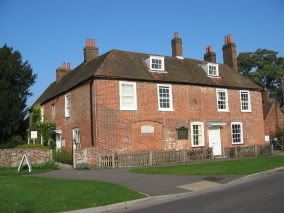
But where were the legions of eager fans queuing up, pouring in, buying postcards that I had expected? Where were the postcards, for that matter? There was no one else about, and the only sign of ‘commerciality’ was that the wooden sign of the teashop across the road was called ‘Cassandra’s Cup’. It was wonderful. I really, truly seemed to have it almost to myself. But I did not want to rush through the experience – I had so long wanted to see it. It had to be stretched out, savoured and made to last as long possible. I started by pacing slowly around the house like an anxious cat for a full five minutes :p.
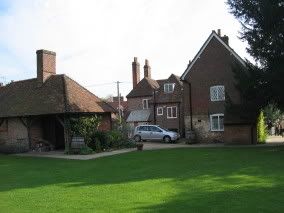
I later discovered that the small shingled, red-painted extension at the left of the main building was the kitchen – back then they called them the ‘offices’. It’s now the gift shop. In the outbuildings to the far left is where they did their washing and baking. Before going in, I paused at the plaque on the outside wall …
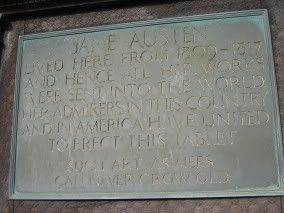
JANE AUSTEN lived here from 1809 to 1817 and hence all her works were sent into the world. Her admirers in this country and in America have united to erect this Tablet.
“Such art as hers can never grow old.”
*sniffs*
Oh – how Jane would surely have laughed at the incredibly solemn, painstaking reverence with which I explored her home! At the hours – literally, more than two of them – I took in poring over every letter, painting, memento, reading every word of each description, on display. And there was so much to see, a lot more than I had expected. The house is quite full, including furniture, china, samplers, her piano, and other family possessions. Some of my favourite things: the ladies’ ‘best’ evening wrap (a gauzy white one with glossy white flowers) which was worn when they went visiting or on special occasions by Jane, her sister Cassandra or their mother – all depending on who was going away to stay with some grander relatives, or – perhaps – simply insisted loudest it was her turn to have it. There were also the topaz crosses she and her sister got from their sailor brother (see ‘Mansfield Park’), an exquisite lace shawl (to be tied around and worn over the neck of a dress) that she had made, and an intricate patchwork quilt that was the work of Jane, Cassandra and Mrs Austen. Jane was obviously as gifted in fine needlework as she was with her pen and, from comments she made in her letters, took almost equal pride in it.
But there were also all kinds of other memorabilia – either hers personally, or from her family. Such as an official gift from some Eastern potentate that her brother, Admiral Austen, got at the height of his splendid career and the bed he took with him on all his ships (it could be easily taken apart and put back together), a lock of her father’s hair in the mourning brooch she wore, and – extremely poignant – the letter that Cassandra, who loved her dearly, wrote to her niece Fanny describing Jane’s death and her feelings of loss (“She was the gilder of every pleasure, the soother of every sorrow”). Last, but not least, the most moving to me of all, the small round wooden table, between the fireplace and the window in the dining room, on which she wrote. I kept going back to it again and again. Unfortunately, you were not supposed to take any photographs. However, there were really not that many people there and there were a number of times I was completely alone in a room and *ahem* after I saw someone else rather unconcernedly taking some snaps, I did end up trying (and succeeding) in getting away with a couple without flash.
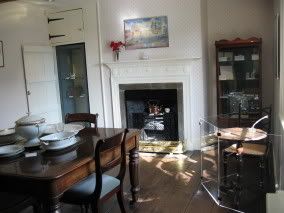
“I look at the small, round table in the house at Chawton at which she revised ‘Sense and Sensibility, Pride & Prejudice and Northanger Abbey, and wrote Emma, Mansfield Park and Persuasion, and am told that when people came into the room she covered her work and put it aside. They deduce from this (a) that she was ashamed of her work and (b) that it was criminal of her to be disturbed in this way. Most writers choose to cover their work when someone else comes into the room. They know it does not appear to best advantage out of context. The fear that, taken line by line, it sounds plain foolish. They don’t want to answer questions. “And who is this Mr Knightley on the third line down? Is he going to marry Emma?” (I daresay two chapters into the work she didn’t know yet….) So the work is covered. It isn’t shame, merely prudence. As for disturbances, some writers thrive on them. For many, if life provides uninterrupted leisure for writing, the urge to write shrivels up. Writing, after all, is part of life – an overflow from it. Take away life and you take away writing. I would have thought the small, round table, half-way between fire and window, sitting with a warm back and life going on the other side of the pane, when you chose to look up from the page, and the occasional knock at the door, and a putting away of the work, was an ideal place and way for any writer to work. It’s how I choose to do it, I know that. I won’t have her pitied for it.”
Fay Weldon – Letters to Alice
Despite the plexiglass surrounding it, and the ‘do not touch’ sign, I could not resist laying laid my hand on the table. I’m the kind of awful tourist who also surreptitously leaned over and gently touched the keys of Mozart’s piano at Bertamka. I must even confess to a – mercifully brief – wild wondering if I could pick off a small splinter from it . My own Sacred Relic. Well, I’m sorry, but there was an incredibly rough bit on a most inconspicuous corner that really looked like it could use some, eh, smoothing out. However the thought of Jane’s opinion to such manners in someone else’s home instantly stayed my hand and made me feel ashamed for it even crossing my mind.
Back and forth, up and down I went in this manner, visiting and revisiting all the corners for quite some time. Even as I was doing it, I was wondering why. Once you’ve seen the exhibits, you seen them, right? Looking back, I think that there was so much great memorabilia, I could not get around this museum ‘atmosphere’. I knew she had lived within these walls, but I could not really feel it. It rather distressed me, and I am thankful it was so quiet that I had the opportunity to go over the place as much as I wanted to my heart’s content with relatively few other visitors. But I did ‘find’ Jane, finally. Tripping down the stairs after my third or – who knows – fourth visit to her bedroom, I knew that the second to the last stair was going to creak again when I stepped on it, just like I know exactly which ones creak in my home. And I suddenly had the feeling as I swung around the corner at the bottom of the landing that I could well come face to face with her as she was heading up, smiling over something she was thinking about, suddenly startled to have someone in front of her. I’ll bet SHE knew that creaking step too! Or maybe not – perhaps it’s something that just started up in the last century or so. It doesn’t matter. Somehow after prowling long enough through her home for it to become comfortable and familiar to me, I could suddenly see and feel her living there. That was the main thing.
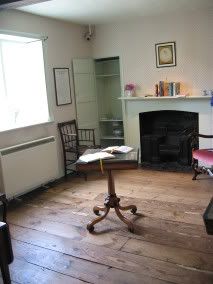
The bedroom Jane shared with her sister Cassandra. The open cupboard on the left was where they performed their ablutions. There was a low basin with space next to it for a water jug, and the shelf above it had a rounded space cut in so they could lean in and wash/rinse their faces and hair without bumping their heads when they straightened up (according to the information Tomalin gathered, Jane must have been on the tall side). The shelf below was where they kept the chamber pot. The first thing that popped into my mind when I saw it was, ‘Shelves in a closet – happy thought!’ :p
After that I went to the gift shop, which actually was the kitchen in the Austen family’s time. They had a great collection of stuff: books, CDs, DVDs, video and a huge variety of gift items. Some of it – especially certain books and filmed versions of the novels, I think may be rather hard to find elsewhere. I ended up buying the sweetest, most exquisite boxed collection you can imagine of her six major books. They are exactly of the snug, compact size that many novels actually were in her day. Remember the one that Lizzie in the BBC series had in her hand when Miss Bingley insisted she ‘take a turn about the room’? That’s how small they are.
Up until now, I only had my one, monstrous (five-pound) tome of ‘The Collected Works of Jane Austen’ and separate cheap paperback copies of ‘Emma’ and ‘Pride and Prejudice’ that I’d purchased at certain times while travelling because I did not (of course) have the ‘monster’ with me, but wanted to read them again on the spur of the moment. I cannot tell you how lovely these little books are. You can really tuck them right into your purse or even a large pocket – yet they read incredibly ‘comfortably’ as far as the size of the pages and letter-type go.

Look how tiny, compared to the ‘monster’ and – for ‘perspective’ a wineglass.
And they are so delightfully finished with built-in bookmarks of red satin ribbon and this fragile kind of gold-leaf at the edge of the pages. You actually have to take care when you turn certain pages the first time to separate – almost ‘cut’ them by delicately running your finger up between them: it makes the most satisfying crinkle-zip sound. I started with Sense & Sensibility and am now working my way onwards in the order they were published to make them truly ‘mine’.
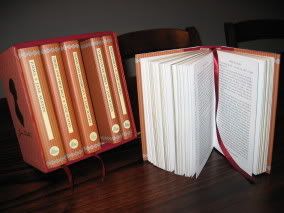
Aren’t they beautiful? *love* *love* *love*
After an invigorating cup of tea and a scone with homemade jam in Cassandra’s Cup, I headed back to Winchester. Once there, I went to the Cathedral to visit her final resting place. When I walked in, there was a service going and the most magnificent choir was singing. It was really a magical moment. They must have been 30-strong, and all the more astonishing as I think the total number of worshippers was probably half that. I quietly made my way along the far left end of the chancery and stood for a number of long minutes, awed and moved, above the slab that covers her grave, wishing so much she could have known how known how magnificently her work would stand the test of time, and how much it still speaks to so very many people today. It rather ticked me off off that in the long, eloquent text two of her brothers wrote for the slab they just go on and on about her Christian virtues and did not mention a word about her writing. Oh well, it has since been rectified by a memorial on the wall and even a specially commissioned stained glass window right above it.
My pilgramige to Chawton was an even more perfect and wonderful experience than I had dared hope it would be. I fervently wish that everyone who loves her work as much as I do may someday have a similar one.

